Caterpillars come in an incredible array of colors, patterns, and shapes. Among the most striking are those with bold black and orange markings. These eye-catching caterpillars are found throughout the United States, munching on various plants in gardens, fields, and forests.
In this guide, we’ll explore 15 different black and orange caterpillar species that you might encounter. Each entry includes a clear image, a brief description to help identify the caterpillar, bulleted key features, and more detailed information about its characteristics, food sources, and the adult butterfly or moth it transforms into.
Whether you’re an avid gardener, nature enthusiast, or simply curious about the critters in your backyard, this guide will help you identify and appreciate these uniquely colored caterpillars. Let’s get started!
1. Milkweed Tussock Moth Caterpillar
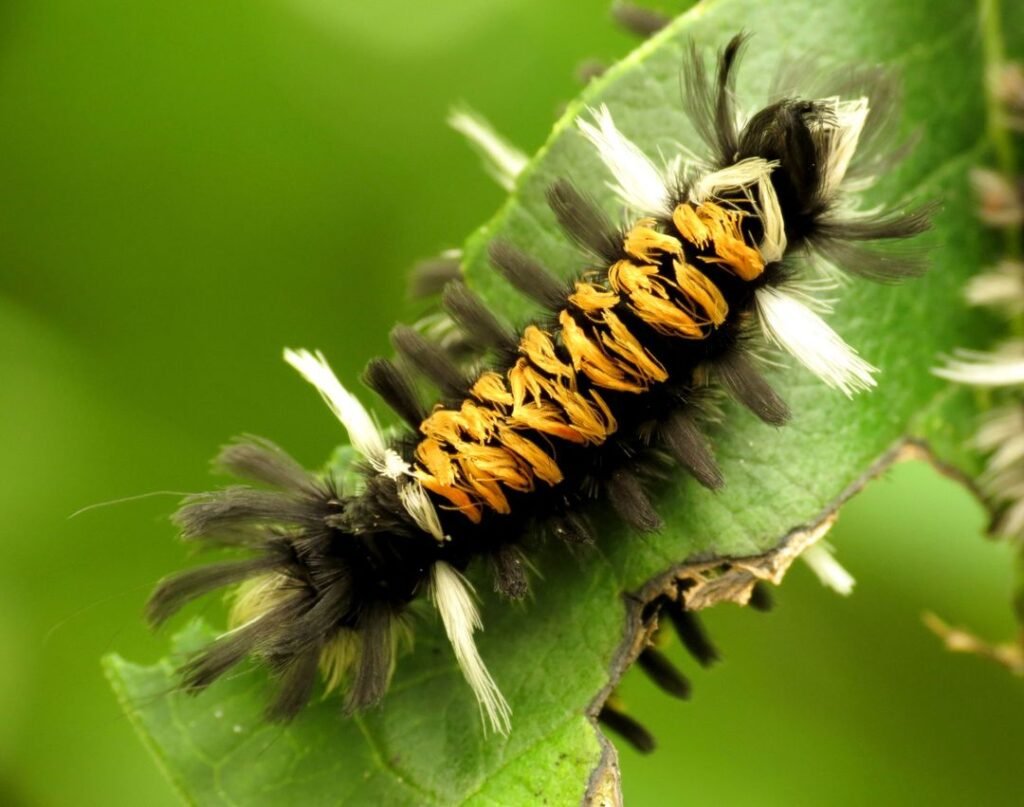
Here is a concise information chart about the Milkweed Tussock Moth caterpillar:
| Category | Information |
|---|---|
| Scientific Name | Euchaetes egle |
| Common Name | Milkweed Tussock Moth caterpillar, Milkweed Tiger Moth caterpillar |
| Life Stage | Larva (caterpillar stage) of the Milkweed Tussock Moth |
| Appearance | Furry caterpillar with tufts of black, white, and orange hairs |
| Size | Up to 1.5 inches (3.8 cm) long when fully grown |
| Habitat | Found in areas with milkweed plants, including meadows, fields, and gardens |
| Diet | Feeds primarily on milkweed leaves |
| Significance | Important for the ecosystem due to their role in controlling milkweed plant populations and as part of the food web |
| Development Stages | Egg, larva (caterpillar), pupa (cocoon), adult moth |
| Predators | Birds, small mammals, and parasitoid insects |
| Defense Mechanism | Toxicity from consuming milkweed, which makes them unpalatable to predators |
| Migration | Not migratory; remains in areas with milkweed plants |
| Conservation Status | Not endangered; populations are stable in suitable habitats |
Strikingly fuzzy black caterpillar with orange stripes and black tufts of hair.
Key Identification Features:
- Distinct black tufts or “tussocks” of hair along its back
- Four orange brushy strips running lengthwise
- Black body covered in soft hairs
The milkweed tussock moth caterpillar is hard to miss with its bold, hairy appearance. It gets its name from the milkweed and other plants it feeds on. While the caterpillar’s hairs can cause skin irritation, the adult moth is harmless. Found throughout North America.
2. Gulf Fritillary Caterpillar
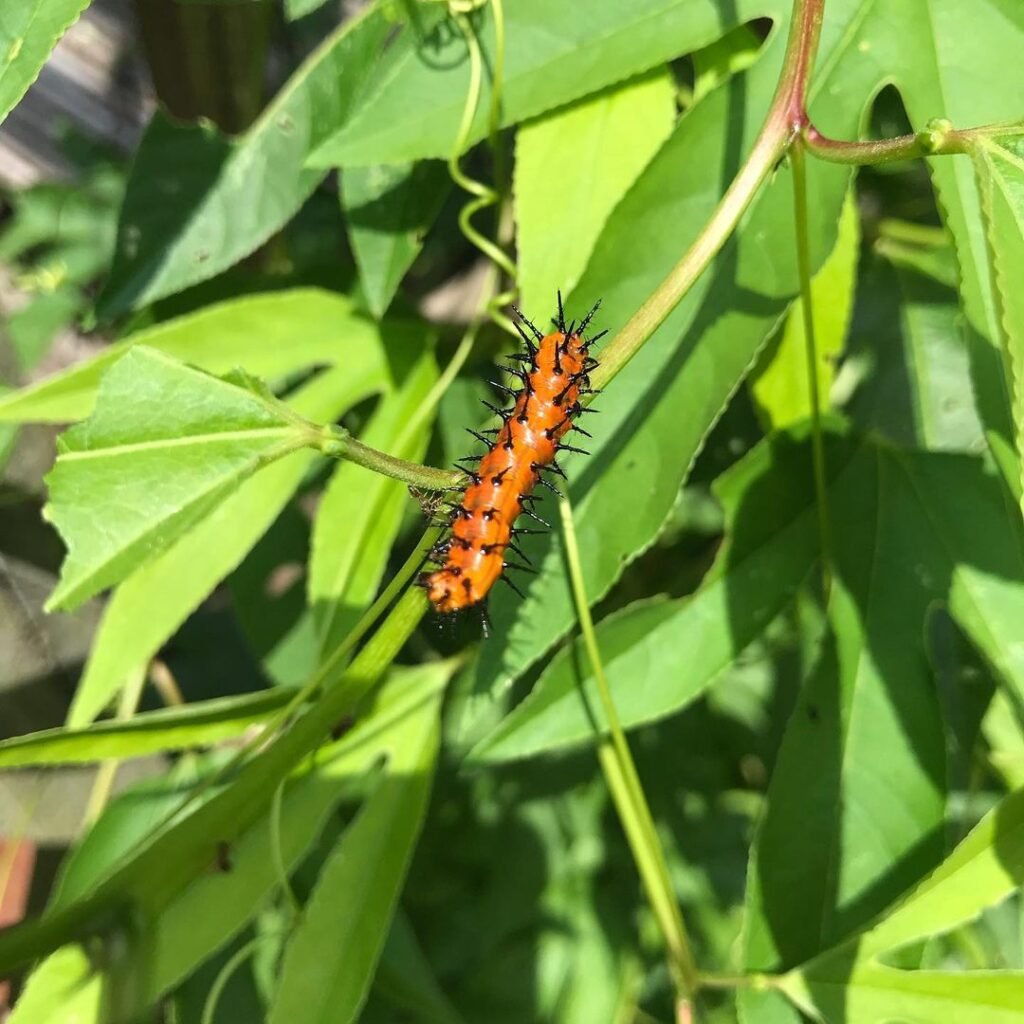
Here is a concise information chart about the Gulf Fritillary caterpillar:
| Category | Information |
|---|---|
| Scientific Name | Agraulis vanillae |
| Common Name | Gulf Fritillary caterpillar |
| Life Stage | Larva (caterpillar stage) of the Gulf Fritillary butterfly |
| Appearance | Bright orange with black spines and black spots |
| Size | Up to 1.5 inches (3.8 cm) long when fully grown |
| Habitat | Found in gardens, fields, and areas with passionflower plants (host plants) |
| Diet | Feeds on leaves of passionflower (Passiflora species) |
| Significance | Important pollinators as adults; caterpillars help control passionflower plant populations |
| Development Stages | Egg, larva (caterpillar), pupa (chrysalis), adult butterfly |
| Predators | Birds, spiders, and predatory insects |
| Defense Mechanism | Bright coloration warns predators of their toxicity |
| Migration | Not typically migratory, but can disperse widely |
| Conservation Status | Not endangered; populations are stable in suitable habitats |
Bright orange caterpillar with black spiny protrusions and white markings.
Key Identification Features:
- Rich orange body
- Rows of black branching spines
- White markings and lines
The gulf fritillary is a striking, spiky caterpillar that feeds primarily on passion vines and other host plants. As it matures, the orange deepens and the white markings become more distinct. Found in southern states, its adult is the beautiful gulf fritillary butterfly.
3. Monarch Caterpillar
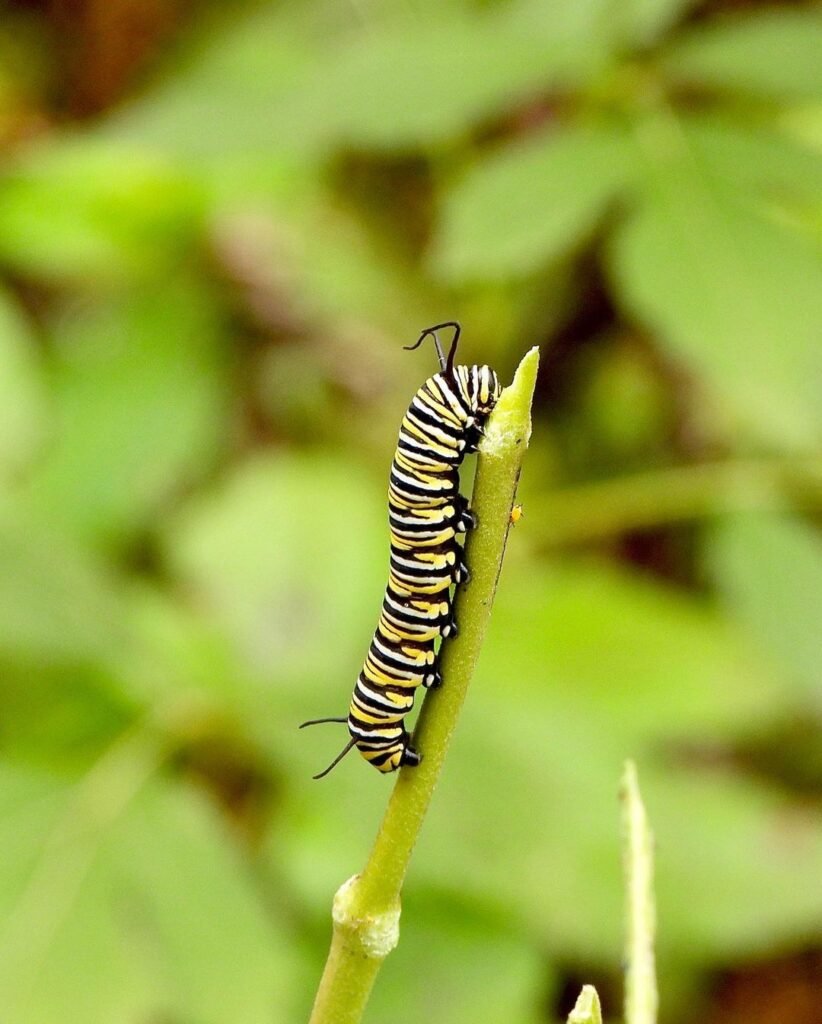
Here is a concise information chart about Monarch caterpillars:
| Category | Information |
|---|---|
| Scientific Name | Danaus plexippus |
| Common Name | Monarch caterpillar |
| Life Stage | Larva (caterpillar stage) of the Monarch butterfly |
| Appearance | Black, white, and yellow striped body |
| Size | Up to 2 inches (5 cm) long when fully grown |
| Habitat | Found primarily on milkweed plants in North America |
| Diet | Exclusively feeds on milkweed leaves |
| Significance | Consuming milkweed makes them toxic to predators |
| Development Stages | Egg, five instars (larval stages), pupa (chrysalis), adult butterfly |
| Predators | Birds, spiders, and parasitic wasps |
| Migration | Part of the migratory species that travel to Mexico for the winter as adults |
| Defense Mechanism | Bright coloration serves as a warning to predators about their toxicity |
| Conservation Status | Not endangered, but populations are declining due to habitat loss and pesticide use |
Iconic striped caterpillar with bands of black, yellow, and white.
Key Identification Features:
- Distinct black, yellow, and white striped pattern
- Two protruding black antennae
- Thin yellow tentacles on body
One of the most recognizable caterpillars, the monarch is beloved for its amazing multi-generational migration. These striped caterpillars strictly feed on milkweed, which gives the adult butterflies toxicity to ward off predators. Found across North America.
In the next section, we’ll cover some fascinating black and orange woolly bear moth caterpillars…
4. Giant Woolly Bear Caterpillar
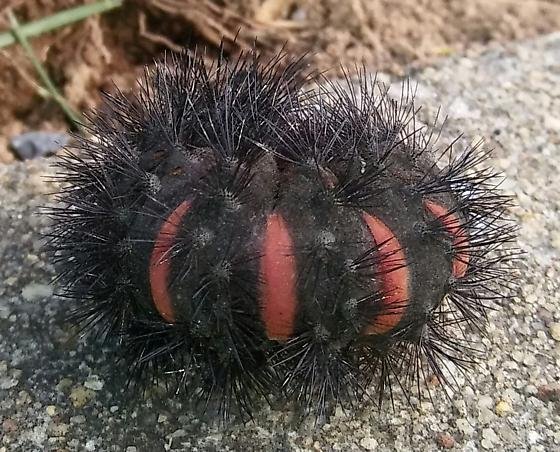
Here is a concise information chart about the Giant Woolly Bear caterpillar:
| Category | Information |
|---|---|
| Scientific Name | Hypercompe scribonia |
| Common Name | Giant Woolly Bear caterpillar, Giant Leopard Moth caterpillar |
| Life Stage | Larva (caterpillar stage) of the Giant Leopard Moth |
| Appearance | Large, black, bristly caterpillar with bright red or orange bands visible between the segments when disturbed |
| Size | Up to 3 inches (7.5 cm) long when fully grown |
| Habitat | Found in forests, gardens, and areas with a variety of host plants |
| Diet | Feeds on a wide variety of plants, including dandelions, violets, and plantains |
| Significance | Part of the ecosystem, contributing to plant population control and serving as prey for other animals |
| Development Stages | Egg, larva (caterpillar), pupa (cocoon), adult moth |
| Predators | Birds, small mammals, and parasitic insects |
| Defense Mechanism | Rolls into a tight ball to protect its soft underside; bristles can be irritating to predators |
| Migration | Not migratory; remains in or near habitat with host plants |
| Conservation Status | Not endangered; commonly found in suitable habitats |
One of the largest woolly bears, with dense black and reddish-orange bristles.
Key Identification Features:
- Very thick coating of bristly hairs
- Black on both ends, reddish-orange middle section
- Can reach 3-4 inches long
The giant woolly bear is indeed giant – one of the biggest fuzzy caterpillars in North America. Its bristly hairs contain toxins to deter predators. These caterpillars overwinter as larvae before emerging in spring as the adult Isabella tiger moth.
5. Banded Woolly Bear Caterpillar
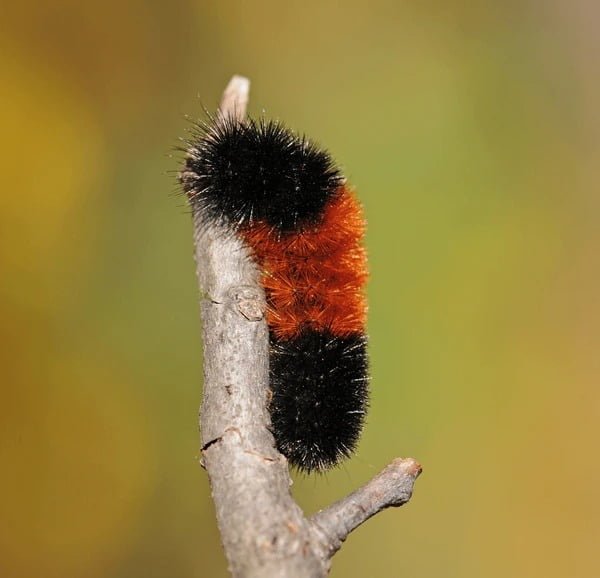
Here is a concise information chart about the Banded Woolly Bear caterpillar:
| Category | Information |
|---|---|
| Scientific Name | Pyrrharctia isabella |
| Common Name | Banded Woolly Bear caterpillar, Woolly Bear caterpillar, Woolly Worm |
| Life Stage | Larva (caterpillar stage) of the Isabella Tiger Moth |
| Appearance | Fuzzy caterpillar with black bands at each end and a reddish-brown or orange band in the middle |
| Size | Up to 2 inches (5 cm) long when fully grown |
| Habitat | Found in meadows, fields, gardens, and areas with low vegetation |
| Diet | Feeds on a variety of low-growing plants, including clover, grasses, and dandelions |
| Significance | Folklore suggests their band width predicts the severity of the coming winter |
| Development Stages | Egg, larva (caterpillar), pupa (cocoon), adult moth |
| Predators | Birds, small mammals, and parasitic insects |
| Defense Mechanism | Rolls into a tight ball to protect its soft underside; bristles may deter some predators |
| Migration | Not migratory; overwinters in caterpillar form, often under leaf litter or bark |
| Conservation Status | Not endangered; widely distributed and commonly found |
Fuzzy black caterpillar with distinct reddish-orange banding in the middle.
Key Identification Features:
- Black furry body on both ends
- Bright reddish-orange banded middle section
- Short bristly hairs
This caterpillar’s distinct segmented banding makes it one of the most recognizable woolly bears around. The banded woolly bear feeds on grasses, clover, and other vegetation before pupating into a nondescript moth. Common across most of the United States and southern Canada.
Some friends love woolly bears for their folk wisdom about upcoming winter forecasts – the wider the orange band, the milder the winter! While not scientifically proven, it’s a fun tradition.
6. Salt Marsh Moth Caterpillar
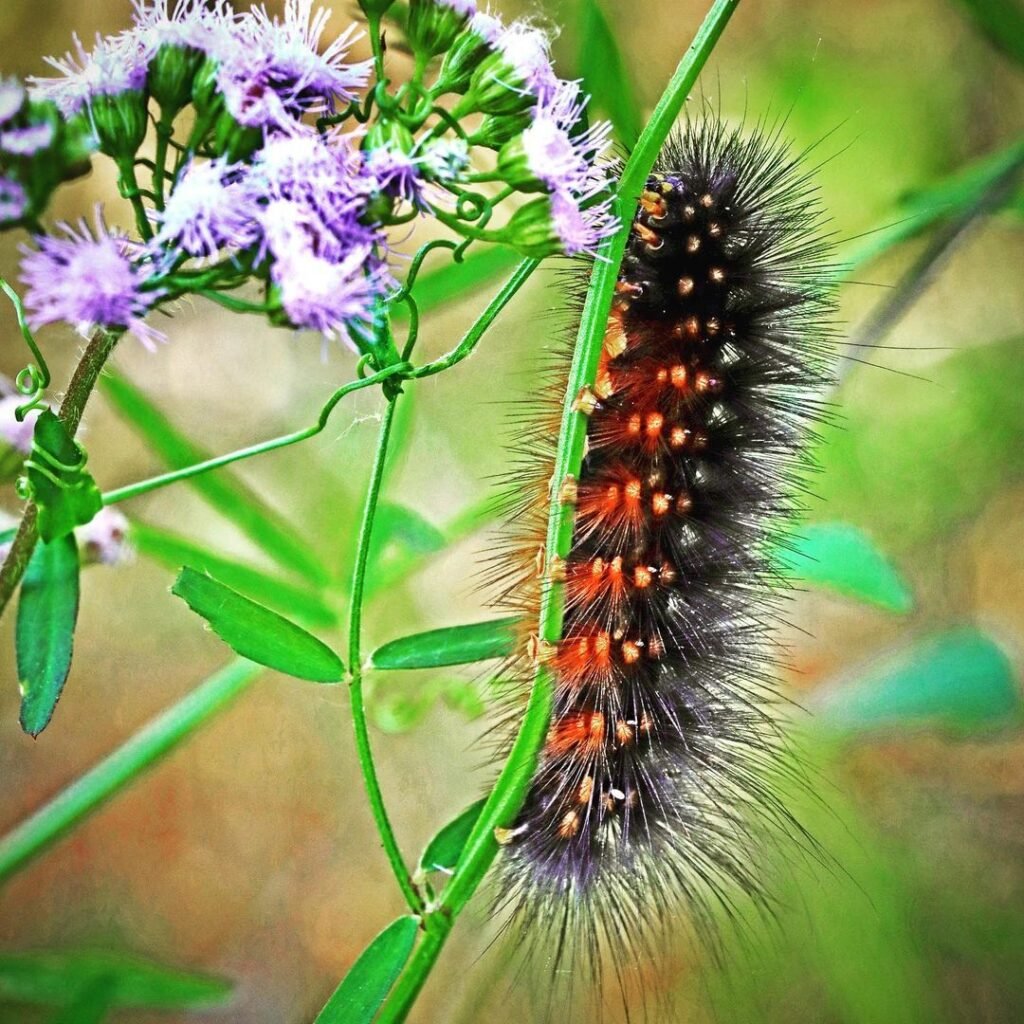
Here is a concise information chart about the Salt Marsh Moth caterpillar:
| Category | Information |
|---|---|
| Scientific Name | Estigmene acrea |
| Common Name | Salt Marsh Moth caterpillar, Acrea Moth caterpillar |
| Life Stage | Larva (caterpillar stage) of the Salt Marsh Moth |
| Appearance | Fuzzy caterpillar with long, dense hairs that can be white, yellow, orange, or black, often mixed |
| Size | Up to 2 inches (5 cm) long when fully grown |
| Habitat | Found in a variety of habitats including salt marshes, meadows, gardens, and fields |
| Diet | Feeds on a wide range of plants, including clover, grasses, and various crops |
| Significance | Can be a pest in agricultural areas due to its broad diet |
| Development Stages | Egg, larva (caterpillar), pupa (cocoon), adult moth |
| Predators | Birds, small mammals, and parasitic insects |
| Defense Mechanism | Long hairs can be irritating to predators and may cause mild skin irritation in humans |
| Migration | Not migratory; remains in or near habitat with host plants |
| Conservation Status | Not endangered; commonly found and widely distributed |
Hairy black caterpillar with vibrant reddish-orange stripe down its back.
Key Identification Features:
- Dense black hairs
- Single bold reddish-orange dorsal (back) stripe
- Small tufts near head and rear end
The striking saltmarsh moth caterpillar is pretty unmistakable with its fuzzy black body and that vivid reddish-orange racing stripe down its back. Despite its ominous appearance, the hairs are not urticating (shouldn’t cause skin irritation). Adults are nondescript brown moths.
Continuing on, here are a few eye-catching black and orange inchworm varieties…
7. Elbowed Spanworm Caterpillar
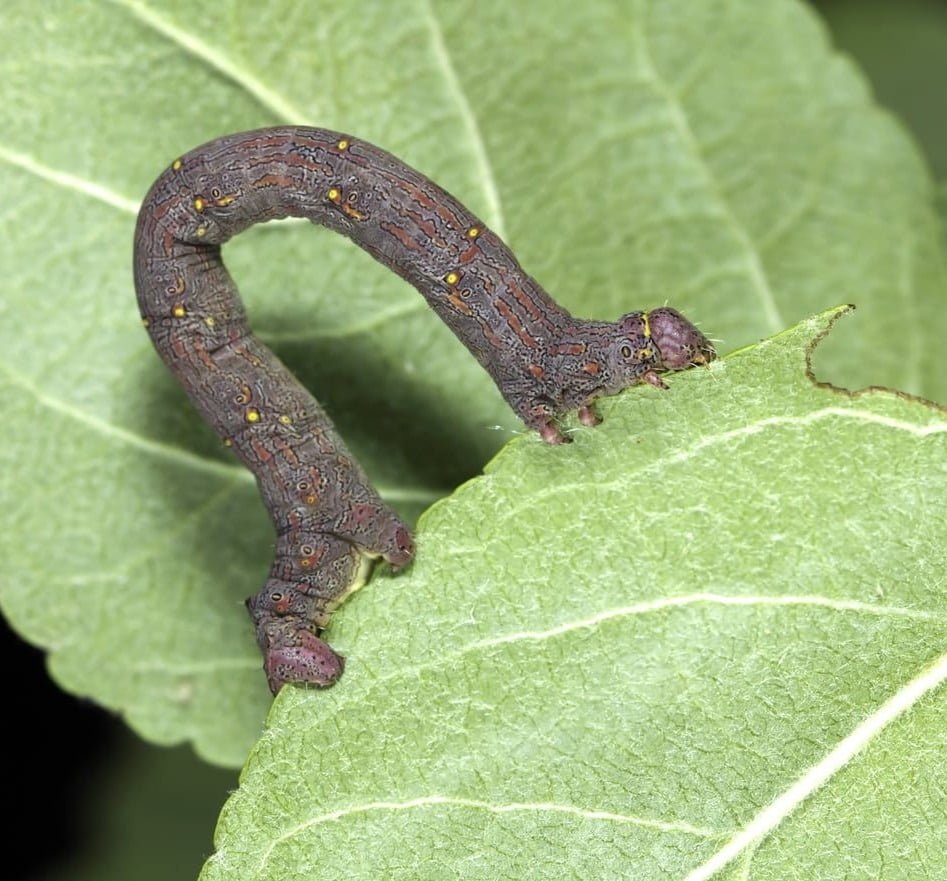
Here is a concise information chart about the Elbowed Spanworm caterpillar:
| Category | Information |
|---|---|
| Scientific Name | Hypomecis umbrosaria |
| Common Name | Elbowed Spanworm caterpillar |
| Life Stage | Larva (caterpillar stage) of the Elbowed Spanworm Moth |
| Appearance | Brown or green with a twig-like appearance; slender and can mimic small branches or twigs when at rest |
| Size | Up to 1.5 inches (3.8 cm) long when fully grown |
| Habitat | Found in forests, woodlands, and areas with deciduous trees |
| Diet | Feeds on the leaves of a variety of deciduous trees, including oak, maple, and birch |
| Significance | Part of the forest ecosystem, contributing to leaf litter decomposition and serving as prey for other animals |
| Development Stages | Egg, larva (caterpillar), pupa (cocoon), adult moth |
| Predators | Birds, small mammals, and parasitic insects |
| Defense Mechanism | Camouflage by mimicking twigs or branches to avoid predation |
| Migration | Not migratory; remains in or near habitat with host plants |
| Conservation Status | Not endangered; commonly found in suitable habitats |
Long, slender black inchworm with bold reddish-orange stripes running its length.
Key Identification Features:
- Distinctively striped black and reddish-orange
- Looping inchworm movement
- Small knob-like protrusions along its body
You’ll often spot elbowed spanworm caterpillars inching along branches, moving in that classic “inchworm” looping pattern. Their contrasting striped colors make them easy to pick out. Found throughout eastern North America on various trees and shrubs.
8. Cross-Striped Cabbageworm
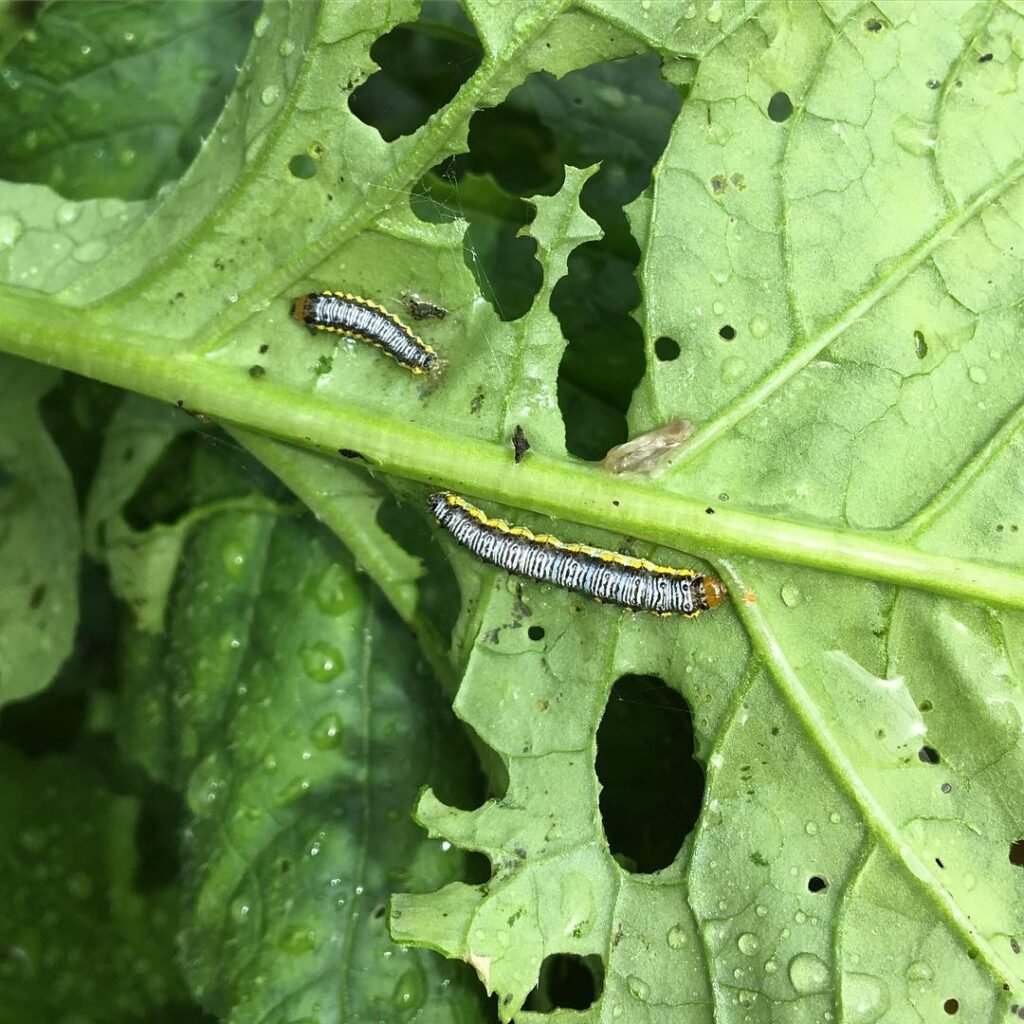
Here is a concise information chart about the Cross-Striped Cabbageworm:
| Category | Information |
|---|---|
| Scientific Name | Evergestis rimosalis |
| Common Name | Cross-Striped Cabbageworm |
| Life Stage | Larva (caterpillar stage) of the Cross-Striped Cabbageworm Moth |
| Appearance | Light blue with black transverse stripes and small black dots |
| Size | Up to 0.75 inches (2 cm) long when fully grown |
| Habitat | Found in gardens and agricultural fields with cruciferous plants (e.g., cabbage, broccoli, and kale) |
| Diet | Feeds on leaves of cruciferous vegetables, causing significant damage to crops |
| Significance | Considered a major agricultural pest due to its feeding habits on economically important crops |
| Development Stages | Egg, larva (caterpillar), pupa, adult moth |
| Predators | Birds, predatory insects, and parasitic wasps |
| Defense Mechanism | Small size and coloration help it blend in with host plants |
| Migration | Not typically migratory; populations can rapidly increase in suitable conditions |
| Conservation Status | Not endangered; considered a pest species |
Pale green caterpillar with distinctive black and yellow cross-striped pattern.
Key Identification Features:
- Light green base color
- Intricate black and yellow/orange cross-striped markings
- No visible protrusions or hairs
The cross-striped cabbageworm is a real beauty with its delicate cross-hatched striping. As its name suggests, this is a major garden pest, feeding on cabbage, broccoli, and other brassica crops. Found across North America, the adult is a small white butterfly.
I love how plump and almost cartoonish these caterpillars look! Handpicking and using row covers are best for control instead of pesticides, to protect pollinators.
Up next, some boldly patterned slug moth caterpillars…
9. Monkey Slug Caterpillar
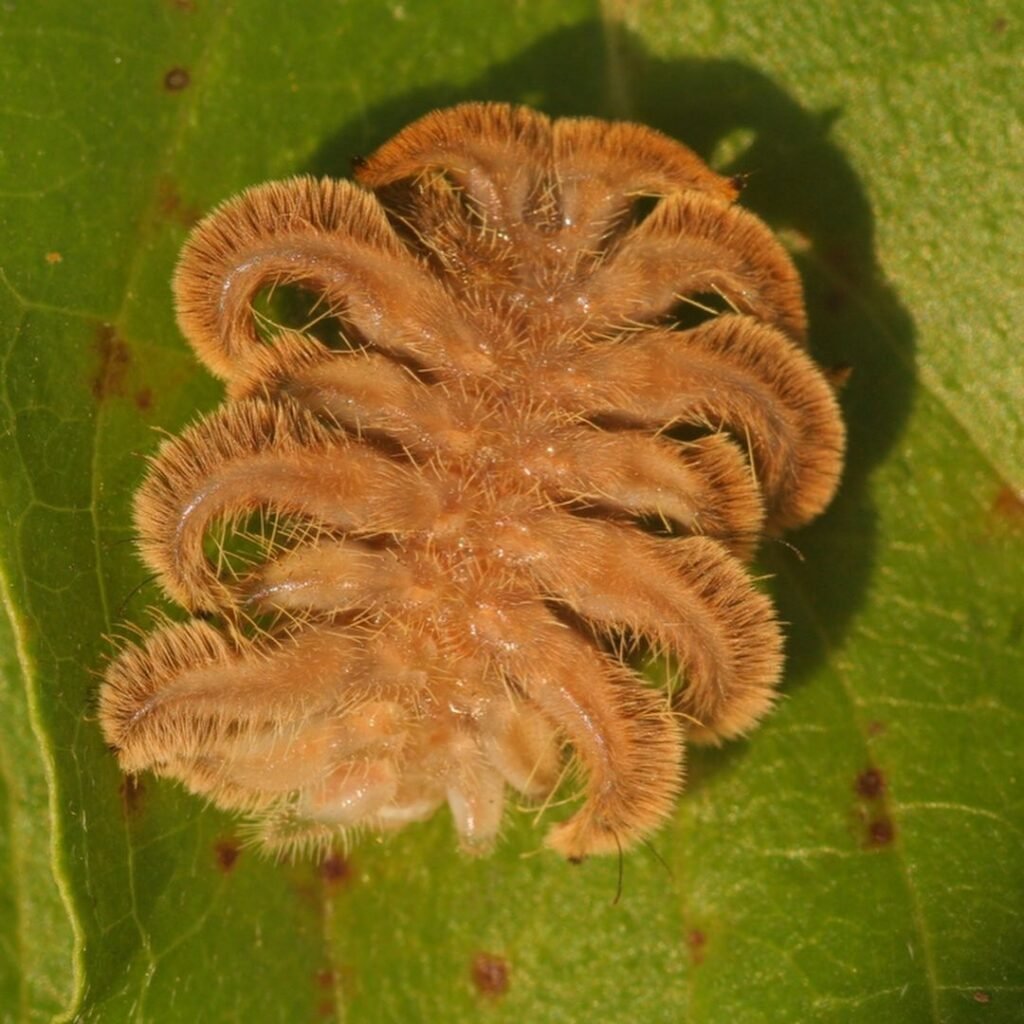
Here is a concise information chart about the Monkey Slug caterpillar:
| Category | Information |
|---|---|
| Scientific Name | Phobetron pithecium |
| Common Name | Monkey Slug caterpillar |
| Life Stage | Larva (caterpillar stage) of the Hag Moth |
| Appearance | Brown and hairy with multiple lobes resembling spider legs or a hairy spider, mimicking a fallen leaf or debris |
| Size | Up to 1 inch (2.5 cm) long when fully grown |
| Habitat | Found in forests, woodlands, and areas with deciduous trees |
| Diet | Feeds on the leaves of a variety of trees including oak, hickory, and persimmon |
| Significance | Part of the forest ecosystem, serving as prey for other animals and contributing to leaf litter decomposition |
| Development Stages | Egg, larva (caterpillar), pupa (cocoon), adult moth |
| Predators | Birds, small mammals, and parasitic insects |
| Defense Mechanism | Camouflage and unusual appearance to deter predators; hairs can cause skin irritation in humans |
| Migration | Not migratory; remains in or near habitat with host plants |
| Conservation Status | Not endangered; commonly found in suitable habitats |
Colorful caterpillar with black and reddish-orange alternating segments.
Key Features:
- Reddish-orange and black segments alternating down its body
- Pair of large protruding eyespots
- Rounded slug-like shape
Monkey slug caterpillars are real oddballs, with their slug-like shapes and eyespots that almost give them a mischievous look. These caterpillars feed on maple, oak, and other deciduous trees, eventually becoming nondescript drab brown moths.
Increasingly, let’s look at some beautiful swallowtail butterfly caterpillars…
10. Tiger Swallowtail Caterpillar
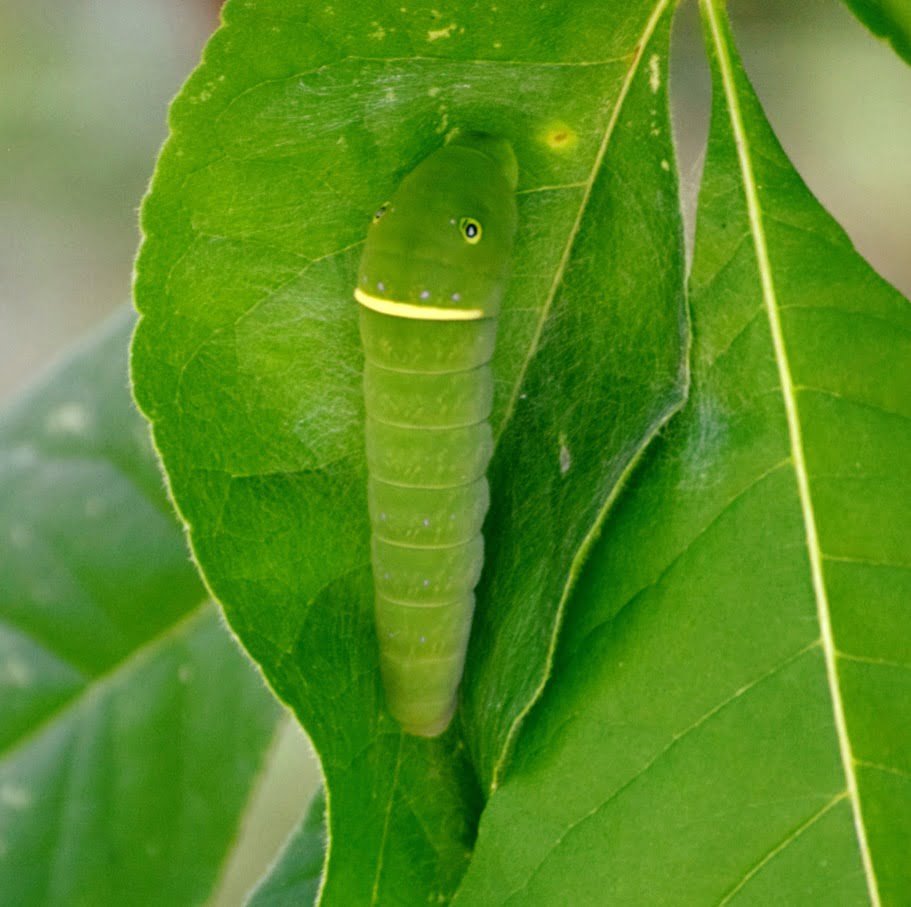
Here is a concise information chart about the Tiger Swallowtail caterpillar:
| Category | Information |
|---|---|
| Scientific Name | Papilio glaucus (Eastern Tiger Swallowtail), Papilio rutulus (Western Tiger Swallowtail) |
| Common Name | Tiger Swallowtail caterpillar |
| Life Stage | Larva (caterpillar stage) of the Tiger Swallowtail butterfly |
| Appearance | Green with large false eye spots on the thorax; resembles a snake to deter predators; early instars are brown and white, resembling bird droppings |
| Size | Up to 2 inches (5 cm) long when fully grown |
| Habitat | Found in forests, woodlands, gardens, and areas with host trees and shrubs |
| Diet | Feeds on leaves of a variety of trees including willow, cherry, ash, tulip tree, and magnolia |
| Significance | Important for pollination as adults; caterpillars help control host plant populations |
| Development Stages | Egg, five larval instars (caterpillar), pupa (chrysalis), adult butterfly |
| Predators | Birds, spiders, and predatory insects |
| Defense Mechanism | False eye spots mimic snake eyes, osmeterium (fleshy organ) emits foul-smelling chemicals when threatened |
| Migration | Not migratory; remains in or near habitat with host plants |
| Conservation Status | Not endangered; populations are stable and commonly found in suitable habitats |
Large green caterpillar with distinct black and yellow striped pattern.
Key Features:
- Bright green base color
- Banding of black and yellow stripes across segments
- Two large protruding eyespots
One of the largest caterpillars around, the tiger swallowtail sports an eye-catching striped pattern that mimics a snake – a clever defense mechanism to scare off predators. These caterpillars feed on willow, ash, and other trees before forming sleek black swallowtail butterflies.
11. Black Swallowtail Caterpillar
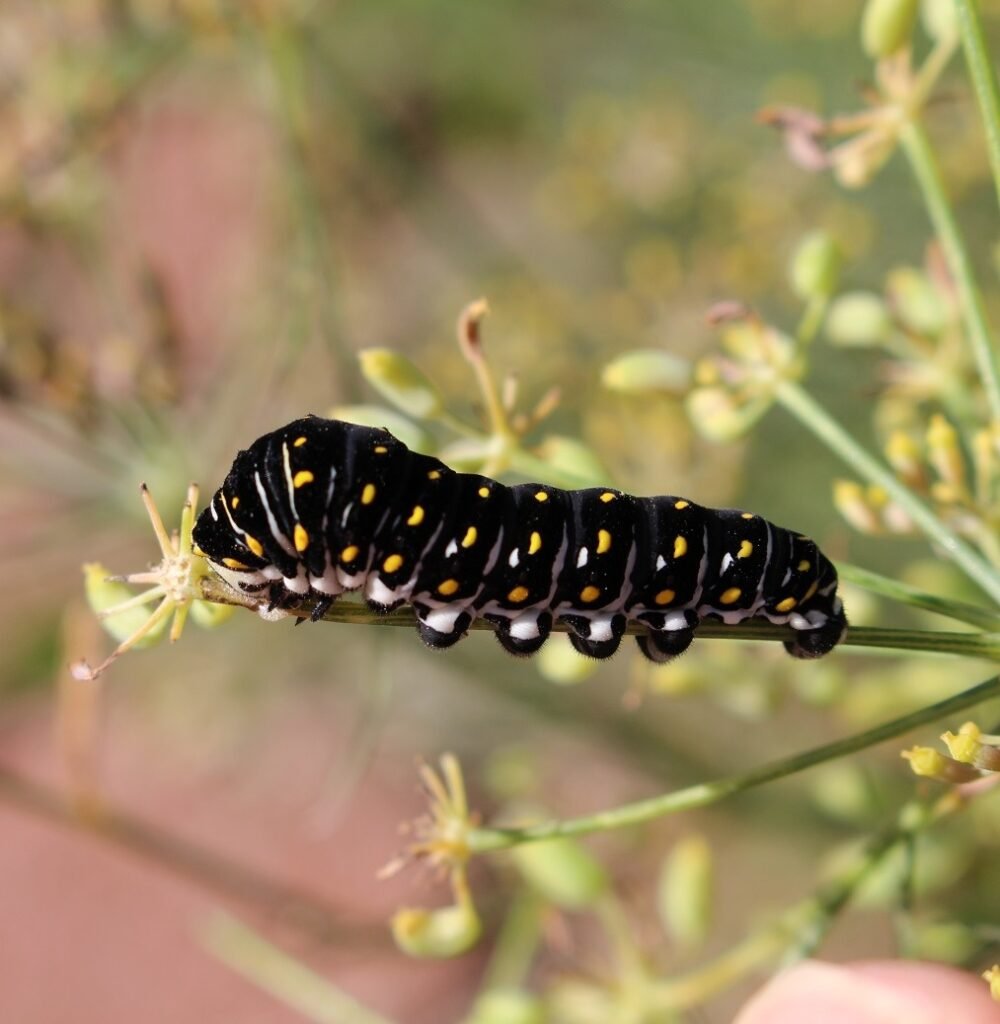
Here is a concise information chart about the Black Swallowtail caterpillar:
| Category | Information |
|---|---|
| Scientific Name | Papilio polyxenes |
| Common Name | Black Swallowtail caterpillar |
| Life Stage | Larva (caterpillar stage) of the Black Swallowtail butterfly |
| Appearance | Black or dark green with yellow spots and stripes; orange osmeterium (defense organ) when threatened |
| Size | Up to 2 inches (5 cm) long when fully grown |
| Habitat | Found in gardens, fields, meadows, and areas with host plants such as parsley, dill, fennel, and carrot |
| Diet | Feeds on leaves of plants in the carrot family (Apiaceae/Umbelliferae) |
| Significance | Important for pollination as adults; caterpillars can sometimes be considered garden pests |
| Development Stages | Egg, five larval instars (caterpillar), pupa (chrysalis), adult butterfly |
| Predators | Birds, spiders, and predatory insects |
| Defense Mechanism | Osmeterium emits foul-smelling chemicals to deter predators; coloration and markings provide camouflage |
| Migration | Not migratory; remains in or near habitat with host plants |
| Conservation Status | Not endangered; populations are stable and commonly found in suitable habitats |
Plump green caterpillar with rows of black and yellow spots.
Key Features:
- Bright green body
- Bands of black spots alternate with yellow spots
- Protruding black osmeterium (“forked tongue”) defense
Black swallowtail caterpillars are pretty unmistakable with their spotted patterns. When threatened, they can stick out their forked osmeterium organ behind their heads to release foul-smelling chemicals. Found across North America on plants like parsley, dill, and carrots.
Moving along to some fuzzy tiger moth caterpillars…
12. Hickory Tussock Moth Caterpillar
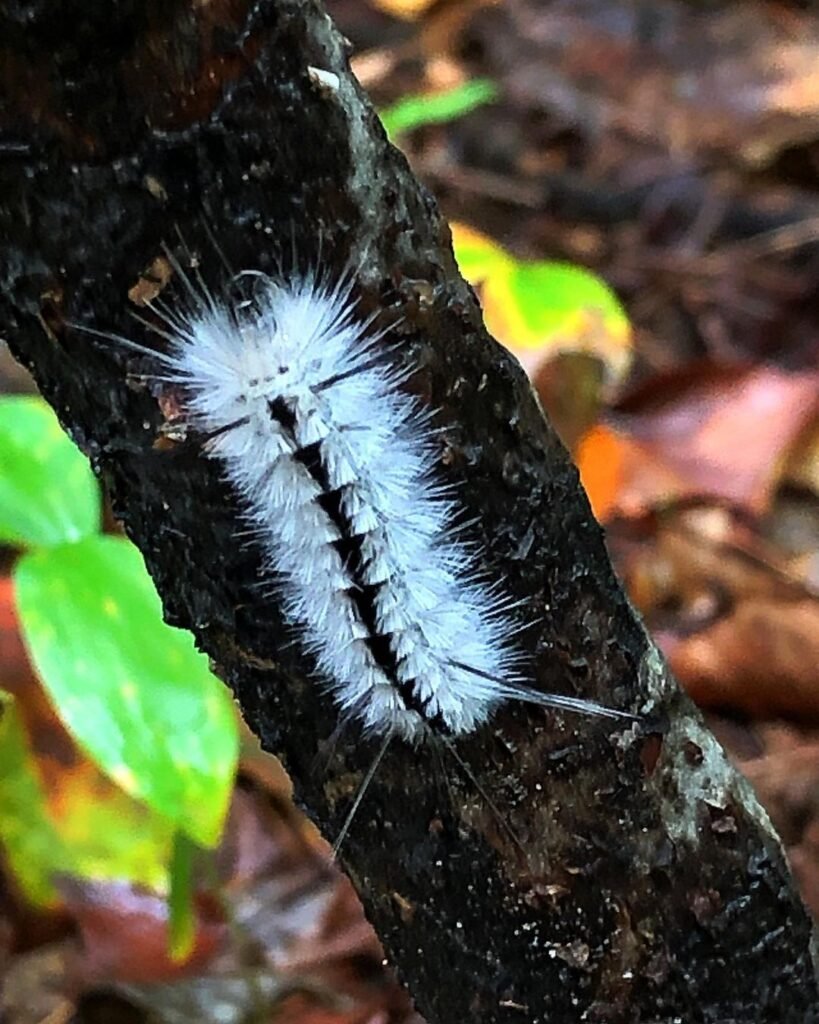
Here is a concise information chart about the Hickory Tussock Moth caterpillar:
| Category | Information |
|---|---|
| Scientific Name | Lophocampa caryae |
| Common Name | Hickory Tussock Moth caterpillar |
| Life Stage | Larva (caterpillar stage) of the Hickory Tussock Moth |
| Appearance | White or cream-colored body with black tufts of hair and a few longer black hairs; orange head and red markings on the back |
| Size | Up to 1.5 inches (3.8 cm) long when fully grown |
| Habitat | Found in deciduous forests, woodlands, and areas with hickory and walnut trees |
| Diet | Feeds on the leaves of hickory, walnut, and other trees in the Juglandaceae family |
| Significance | Can be a pest in forests and urban areas, but also serves as food for predators |
| Development Stages | Egg, larva (caterpillar), pupa (cocoon), adult moth |
| Predators | Birds, small mammals, and parasitic wasps |
| Defense Mechanism | Dense tufts of hair can cause irritation to predators; coloration serves as a warning of potential toxicity |
| Migration | Not migratory; remains in or near habitat with host plants |
| Conservation Status | Not endangered; commonly found in suitable habitats |
Black caterpillar with white tufts alternating with orange and black tufts.
Key Features:
- Dense black furry body
- White tuft protrusions alternate with orange/black tufts
- Long black hairs
Hickory tussock moth caterpillars are real “lookers” with their alternating tufted fur coats. The hairs can cause skin irritation, so best admired from a distance. These caterpillars feed on various nut and fruit trees across the eastern U.S. before becoming nondescript tan moths.
13. Virginia Tiger Moth Caterpillar
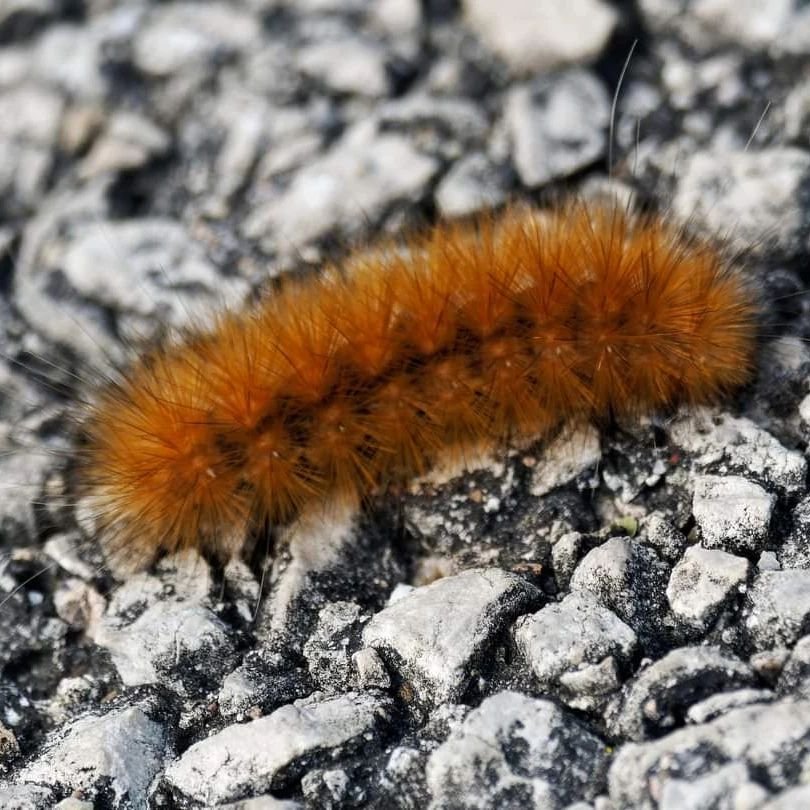
Here is a concise information chart about the Virginia Tiger Moth caterpillar:
| Category | Information |
|---|---|
| Scientific Name | Spilosoma virginica |
| Common Name | Virginia Tiger Moth caterpillar |
| Life Stage | Larva (caterpillar stage) of the Virginia Tiger Moth |
| Appearance | Black and orange/yellow with tufts of hair covering the body |
| Size | Up to 1 inch (2.5 cm) long when fully grown |
| Habitat | Found in a variety of habitats including meadows, fields, and gardens |
| Diet | Feeds on a wide range of plants including grasses, herbs, and garden crops |
| Significance | Part of the ecosystem, serving as food for birds and other predators |
| Development Stages | Egg, larva (caterpillar), pupa (cocoon), adult moth |
| Predators | Birds, small mammals, and predatory insects |
| Defense Mechanism | Tufts of hair can deter some predators and may cause irritation to skin |
| Migration | Not migratory; remains in or near habitat with suitable food sources |
| Conservation Status | Not endangered; populations are stable and commonly found in various habitats |
Fuzzy black caterpillar with long black hairs and reddish-orange stripes.
Key Features:
- Dense black hair covers body
- Two reddish-orange lengthwise stripes
- Long black bristly hairs protrude from sides
These fuzzy caterpillars look like little furry creatures scampering across branches and tree trunks. The virginia tiger moth’s bristly hairs can cause skin rashes and eye irritation, so avoid direct contact. Found throughout eastern North America.
Finally, let’s cover a few more unique orange and black sphinx moth caterpillars…
14. Rustic Sphinx Moth Caterpillar

Here is a concise information chart about the Rustic Sphinx Moth caterpillar:
| Category | Information |
|---|---|
| Scientific Name | Manduca rustica |
| Common Name | Rustic Sphinx Moth caterpillar |
| Life Stage | Larva (caterpillar stage) of the Rustic Sphinx Moth |
| Appearance | Large and robust with a green body, diagonal white stripes, and a horn-like tail |
| Size | Up to 3 inches (7.6 cm) long when fully grown |
| Habitat | Found in various habitats including forests, woodlands, and gardens |
| Diet | Feeds on leaves of a variety of plants including members of the nightshade family (Solanaceae) such as tomato, tobacco, and potato |
| Significance | Plays a role in pollination as adults; caterpillars serve as food for predators |
| Development Stages | Egg, larva (caterpillar), pupa (cocoon), adult moth |
| Predators | Birds, small mammals, and predatory insects |
| Defense Mechanism | Horn-like tail may startle predators; coloration and markings provide camouflage |
| Migration | Not migratory; remains in or near habitat with suitable host plants |
| Conservation Status | Not endangered; commonly found in suitable habitats |
Large green caterpillar with black and orange striped horn.
Key Features:
- Light green body
- Striped black and orange “horn” protrusion
- Pair of circular eyespots
Rustic sphinx moth caterpillars have a classic sphinx form, with their plump green bodies and that amazing striped horn. These feed on plants like elm, ash, and cherry across central and eastern North America before becoming heavy-bodied rustic sphinx moths.
15. Waved Sphinx Caterpillar

Here is a concise information chart about the Waved Sphinx caterpillar:
| Category | Information |
|---|---|
| Scientific Name | Ceratomia undulosa |
| Common Name | Waved Sphinx caterpillar |
| Life Stage | Larva (caterpillar stage) of the Waved Sphinx Moth |
| Appearance | Green with diagonal white stripes along the sides, and a dorsal stripe that is white or light yellow; may have a horn-like projection at the rear end |
| Size | Up to 3 inches (7.6 cm) long when fully grown |
| Habitat | Found in forests, woodlands, and areas with host plants |
| Diet | Feeds on the leaves of various trees and shrubs, including birch, cherry, maple, and willow |
| Significance | Plays a role in pollination as adults; caterpillars serve as food for predators |
| Development Stages | Egg, larva (caterpillar), pupa (cocoon), adult moth |
| Predators | Birds, small mammals, and predatory insects |
| Defense Mechanism | Camouflage and possible mimicry; some species may have an osmeterium (defensive gland) that emits foul-smelling chemicals |
| Migration | Not migratory; typically remains within its habitat |
| Conservation Status | Not endangered; populations are generally stable in suitable habitats |
Large green caterpillar with yellow stripes, black transverse lines, and upturned tail.
Key Features:
- Bright yellowish-green body
- Black transverse lines across segments
- Upturned black tail segment
The colors and patterns on these large waved sphinx caterpillars are just beautiful. You’ll find them feeding on plants like elm, cherry, ash, and others, eventually transforming into the plain but heavy-bodied waved sphinx moth.
Closing Thoughts
There’s no shortage of stunning black and orange caterpillars to discover across the United States! From the iconic woolly bears to the gigantic swallowtail caterpillars, these colorful larvae are true natural wonders.
When out exploring, remember that many caterpillars are protected by bristles, hairs, or toxins, so it’s best to admire them from a distance. Take photos, observe them in action, and appreciate the incredible colors and patterns evolution has produced.
I hope this guide has helped you learn more about some common black and orange caterpillar species in your area. Whether you’re an avid wildlife watcher or backyard gardener, keep an eye out for these beautiful, miniature marvels – you never know what you might find munching away!
Let me know if you have any other questions about identifying these caterpillars. And feel free to share any cool sightings or pictures you’ve captured too. Happy caterpillar watching!
Pingback: 8 Types of Green Insects – Identification Guide -
Pingback: 10 Texas Caterpillars: A Visual Identification Guide -
Pingback: The Stunning Monstera Expilata: A Collector’s Dream Plant -
Pingback: 15 Black and Orange Caterpillars (With Pictures...
Pingback: 29 Beautiful Butterflies You Can Spot in the USA -
Pingback: Caterpillars in California: Exploring the Diverse World
Pingback: Journey into Greenery: Trees That Begin with ‘J’
Pingback: Black and Yellow Caterpillars (With Pictures) – Identification Guide